This post may contain affiliate links. Please read our disclosure policy.
This flavorful loaf of gluten free sourdough bread is made with the simplest wild yeast gluten free sourdough starter. Your basic loaf of sandwich bread, no commercial yeast needed.
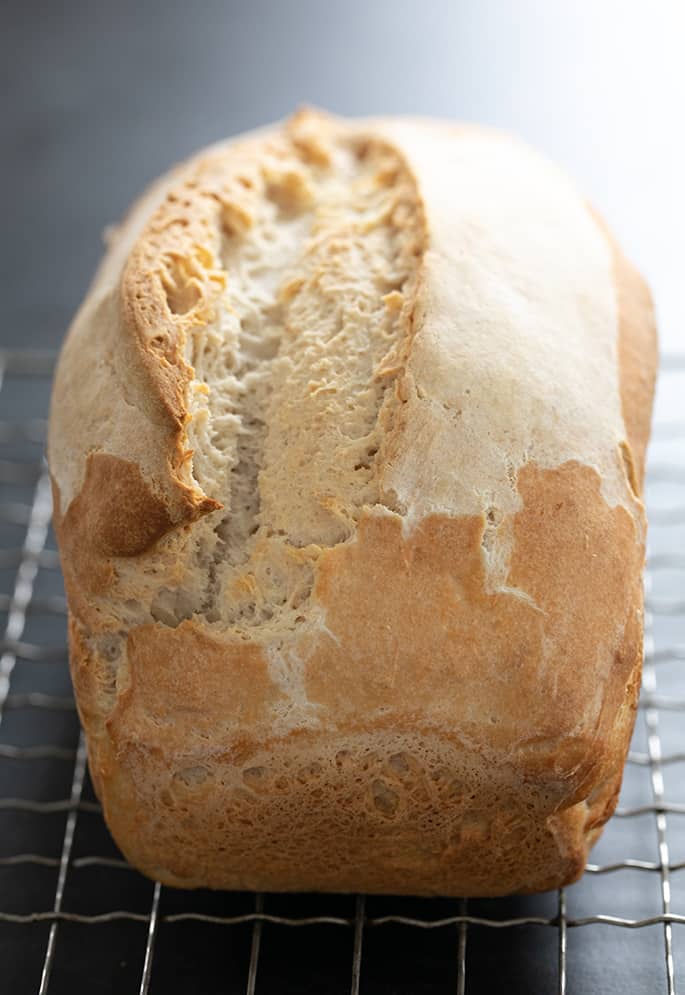
Why make pure wild yeast gluten free sourdough bread?
This recipe for a standard loaf of gluten free sourdough bread and our simplified recipe for gluten free sourdough starter are not designed to be a deep dive into all things sourdough. Our goal here is much simpler.
Indeed, this is a loaf of authentic gluten free sourdough bread, made without any commercial yeast at all. But these recipes are designed to scratch the itch for a fuller-bodied yeasty tasting bread, and to help you enjoy fresh homemade bread if you don't have any commercial yeast.
Think of it more like a workhorse kind of white sandwich bread that's great for lunches. In my bread book, GFOAS Bakes Bread, I have a whole chapter on wild yeast sourdough recipes and we go deep.
Here, we go simple. The rules are a little relaxed, but the process takes less work. And frankly I believe that the deep dive in Bakes Bread really illustrates why I still love traditional cookbooks that can really explore a whole subject.
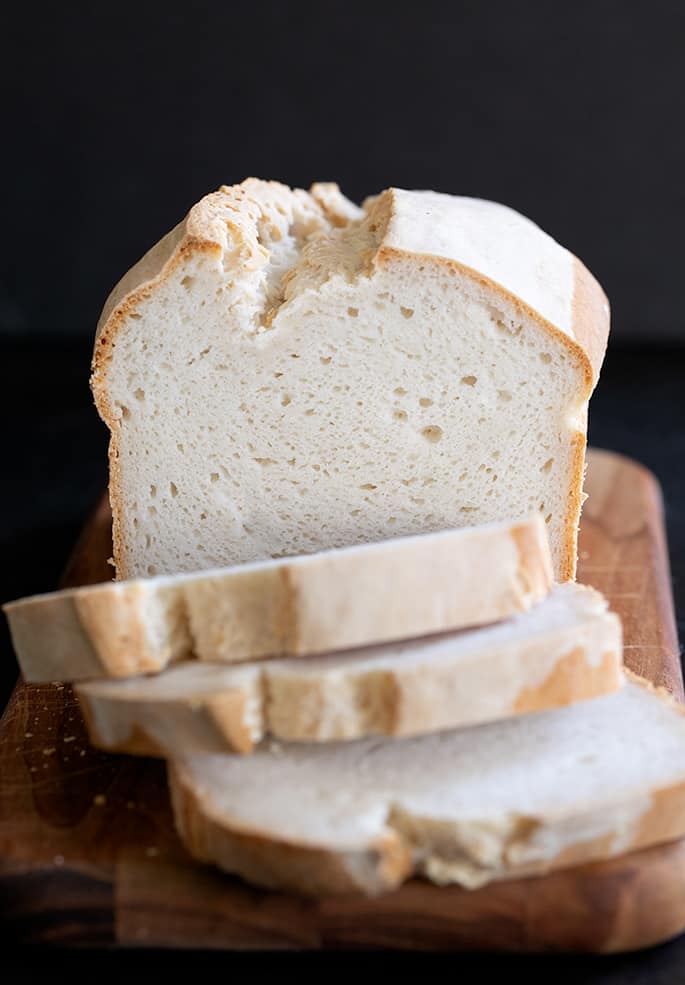
How to bake gluten free sourdough bread
How to use a gluten free sourdough starter
Before we begin discussing how to make bread with your active, fed wild yeast sourdough starter, let's first make sure you have one (click thru earlier in this paragraph)! If you don't, no worries at all you've come to the right place.
Keep in mind that a wild yeast sourdough starter (one made without any commercial yeast, which is a single strain of yeast) takes at least 5 days to become active. And it will perform best after about 10 days.
You can speed things up by adding a bit of commercial yeast to your starter. If you have commercial yeast on hand and you need a loaf of bread today, I recommend our simplest gluten free bread recipe.
But if you've been confused by sourdough starters in the past, try to stick with us. We've simplified the process significantly, so click through above.
It includes an instructional video to bring it to life, and frequently asked questions to help soothe your worried sourdough soul.
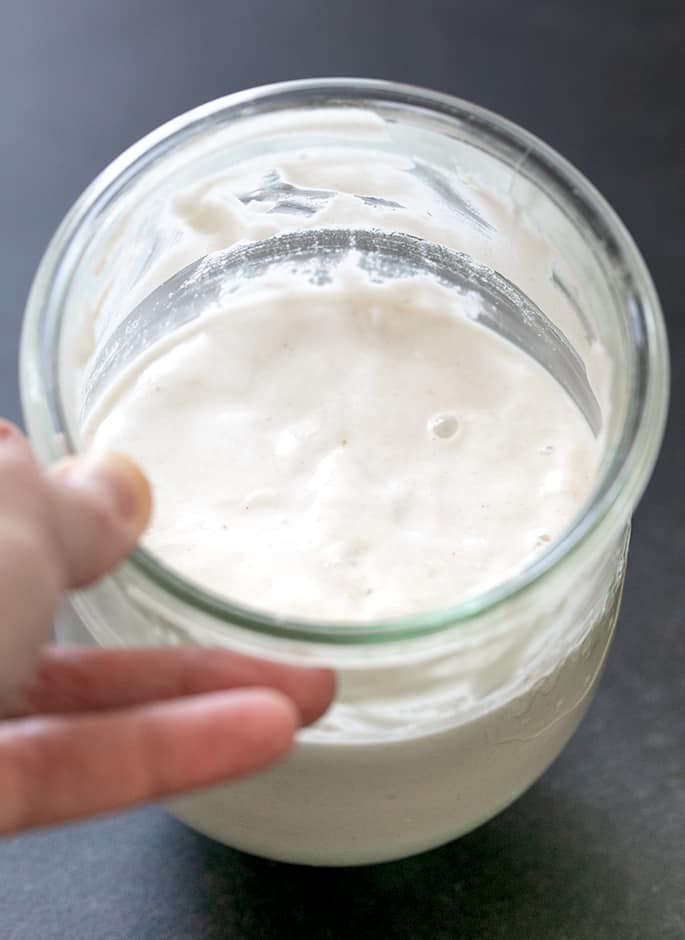
How to feed your gluten free sourdough starter for use
Your starter must have been “fed” or “refreshed” within the previous 12 hours for it to work in this recipe. Do not proceed with an active starter that hasn't been fed recently. The yeast will have consumed its available food and simply won't be active enough to give a proper rise to a whole loaf of bread.
Once your starter is mature and active, it will need to be refreshed or fed at least once a week to keep it active. That way, when you are ready to bake with it, the wild yeast is alive and waiting for you.
To refresh or feed your sourdough starter, either to keep it active once a week or because you are preparing to bake with it:
- Remove your mature starter from the refrigerator.
- Discard about 1/3 of the volume (including any clear liquid or hooch from the top).
- Add 1/2 cup (70 grams) gum-free gluten free flour and 1/2 cup (4 fluid ounces) spring water or distilled water. Mix with a nonreactive spoon.
- Cover the starter and allow it to sit, covered, at room temperature for about 2 hours or until it is bubbling and active. It is now ready to use in baking.
- Once you've removed the amount of active, fed starter that you need for baking, repeat the process to feed or refresh the starter, then cover it again and allow it to sit on the counter for 12 hours before returning it to the refrigerator for another week, until it needs to be fed again.
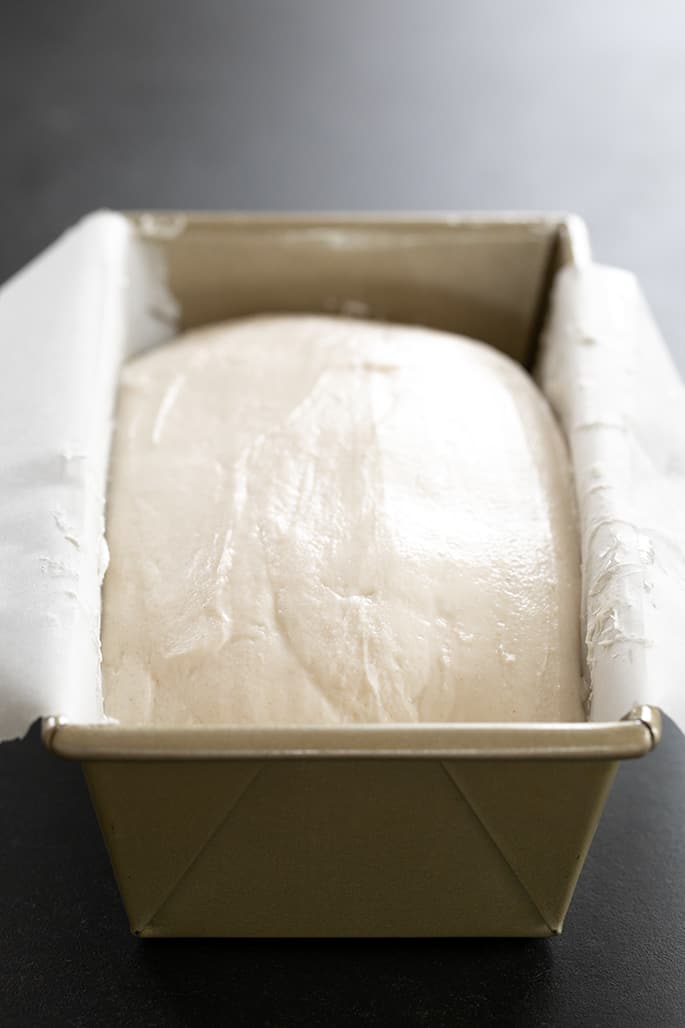
Gluten free sourdough bread: ingredients and substitution suggestions
Gluten free dairy free sourdough bread
You should be able to replace the dairy in this bread recipe successfully. The milk can be replaced with unsweetened nondairy milk (my favorite is almond milk), or even with water. If you replace the milk with water, your loaf will simply be a bit less tender but it should still rise.
I haven't tried replacing the butter with a nondairy replacement, but you should be able to use your favorite vegan butter alternative. I only recommend using a butter alternative like Melt or Miyoko's Kitchen brand vegan butter or Earth Balance, and not oil.
Tapioca starch/flour
When I was first testing this recipe, I made it with 3 1/2 cups of all purpose gluten free flour, and the dough didn't rise as readily and the crumb was tighter. I much prefer the recipe made with 1/2 cup of tapioca starch/flour.
If you don't have tapioca starch, you can try using arrowroot in its place, or even another 1/2 cup of all purpose gluten free flour. I'm afraid I can't predict exactly what results you'll get, though.
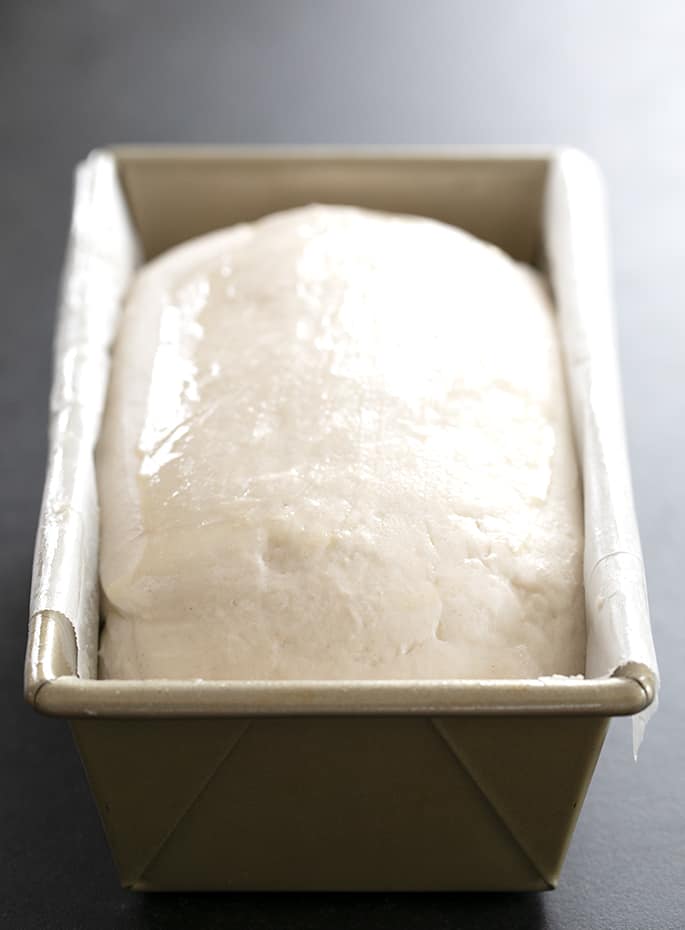
FAQs
Since this bread is made with a very simple, liquid sourdough starter, it will not rise like the breads in Bakes Bread. If you have that book, turn to the opening section of the sourdough chapter. You'll find a photo of sourdough bread dough that literally popped like a can of biscuits when I opened it after its refrigerator rise.
This recipe is for a batter-style bread, not our bread recipes that call for the more complex gluten free bread flour so it has only one rise. And produces a more ordinary loaf. But when you're baking with limits, “ordinary” can be amazing, especially when it comes to fresh homemade bread.
This rise takes quite a bit of time. In all of my recipe testing, I'm yet to see a rise that took less than 3 hours, and have even let it rise for 8 hours without overproofing.
If you’re unsure about whether or not the bread has proofed enough, allow it to keep rising.
The dough should rise to about 150% of its original size when it's done proofing. That means that it should be 50% bigger than when it started. Unlike conventional bread, this loaf will not double in size, or rise to 200% its original size. Unlike bread made with conventional yeast, it will have more oven spring, where the yeast speeds up the fermentation process in the beginning of baking before a crust forms, so it will get considerably bigger during baking.
Overproofed dough like this tends to have little dimples on the surface, and that tends to take much longer to happen here than it does in a recipe made with conventional yeast. Once those dimples start to form, your bread shouldn't rise any longer.
Yes, since this recipe rises so slowly without overproofing, you can make the dough before bedtime, shape it in the loaf pan, cover the pan, and set it to rise during the night. When you wake up, bake the loaf and enjoy. You can also start the process in the morning, let it rise and bake about an hour before dinnertime.
When this loaf is done baking, the center of the loaf will read 200°F on an instant read thermometer and the loaf will sound hollow when thumped quickly on the underside with a finger.
How to make gluten free sourdough bread
Gluten Free Sourdough Bread Recipe
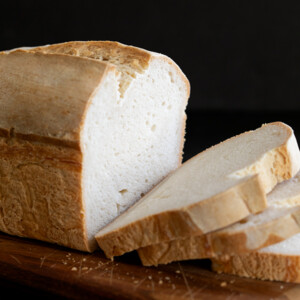
Equipment
Ingredients
- 3 cups (420 g) all purpose gluten free flour blend, (I used & highly recommend Better Batter; click thru for details)
- 1 ½ teaspoons xanthan gum, omit if your blend already contains it
- 9 tablespoons (68 g) tapioca starch/flour
- 2 tablespoons (25 g) granulated sugar
- 1 ½ teaspoons (9 g) kosher salt
- ¾ cup (165 g) gluten free wild yeast sourdough starter, fed within previous 12 hours (See Recipe Notes)
- 1 ½ cups (12 fluid ounces) warm milk, (about 95°F), plus more by the tablespoon
- 4 tablespoons (56 g) unsalted butter, at room temperature
Instructions
- Grease a standard 9-inch x 5-inch loaf pan and line with parchment paper. Set the pan aside.
- In the bowl of a stand mixer fitted with the paddle attachment or a large bowl with a hand mixer fitted with dough hooks, place the all purpose flour, xanthan gum, tapioca starch/flour, granulated sugar, and salt, and mix or whisk to combine well.
- Add the starter, 1 1/2 cups of milk, and the butter, and beat on medium speed to combine. This is a batter-style bread dough, so it won’t resemble traditional bread dough, but rather a soft cookie dough.
- Turn the mixer up to medium-high speed and beat until the dough has taken on a whipped appearance (about 5 minutes). The dough should be tacky to the touch, but should hold its shape when scooped.
- If your dough feels at all dry to the touch, add more milk by the tablespoon, beating it in until well-combined, until the dough reaches the proper consistency.
- Transfer the bread dough to the prepared loaf pan. Using a moistened spatula, press the dough into every corner of the loaf pan and spread the top into an even layer.
- For a more traditional loaf shape, pile the dough a bit more toward the center in a dome.
- Cover the loaf pan with lightly oiled plastic wrap and allow it to rise in a warm, draft-free place until it’s reached about 150% of its original size, at least 4 hours. It will not fully double in volume, and will rise more in the oven than it does raw.
- Even traditional yeast bread dough will take longer to rise properly in colder, drier weather and less time in warmer, more humid weather.
- This wild yeast sourdough bread will take longer to rise than any other, and will depend in part upon the age of your starter.
- This bread dough is much less likely to overproof and take on that pock-marked appearance than bread made with conventional yeast. If you’re unsure about whether the bread has proofed enough, allow it to keep rising.
- When the bread is nearing the end of its rise, preheat your oven to 400°F.
- Remove the plastic wrap and, using a sharp knife or lame, slash the top of the loaf from one short end to the other about 1/4-inch deep.
- Place the pan in the center of the preheated oven and allow to bake for 30 minutes.
- Reduce the oven temp to 350°F, rotate the pan 180° around, and continue to bake until center of the loaf reads 200°F on an instant read thermometer (about 30 minutes more).
- The crust won’t darken very much, but the loaf should sound hollow when thumped quickly with a finger.
- Remove the pan from the oven and allow the bread to cool for about 10 minutes in the pan before transferring to a wire rack to cool completely before slicing and serving.
- To freeze the bread, cool the loaf completely, then slice, wrap tightly and freeze the slices. Defrost as many slices at a time as you need in the toaster.
Video
Notes
- Remove your mature starter from the refrigerator.
- Discard about 1/3 of the volume (including any clear liquid or hooch from the top).
- Add 1/2 cup (70 grams) gum-free gluten free flour and 1/2 cup (4 fluid ounces) spring water or distilled water. Mix with a nonreactive spoon.
- Cover the starter and allow it to sit, covered, at room temperature for about 2 hours or until it is bubbling and active. It is now ready to use in baking.
- Once you've removed the amount of active, fed starter that you need for baking, repeat the process to feed or refresh the starter, then cover it again and allow it to sit on the counter for 12 hours before returning it to the refrigerator for another week, until it needs to be fed again.
Nutrition information is automatically calculated, so should only be used as an approximation.
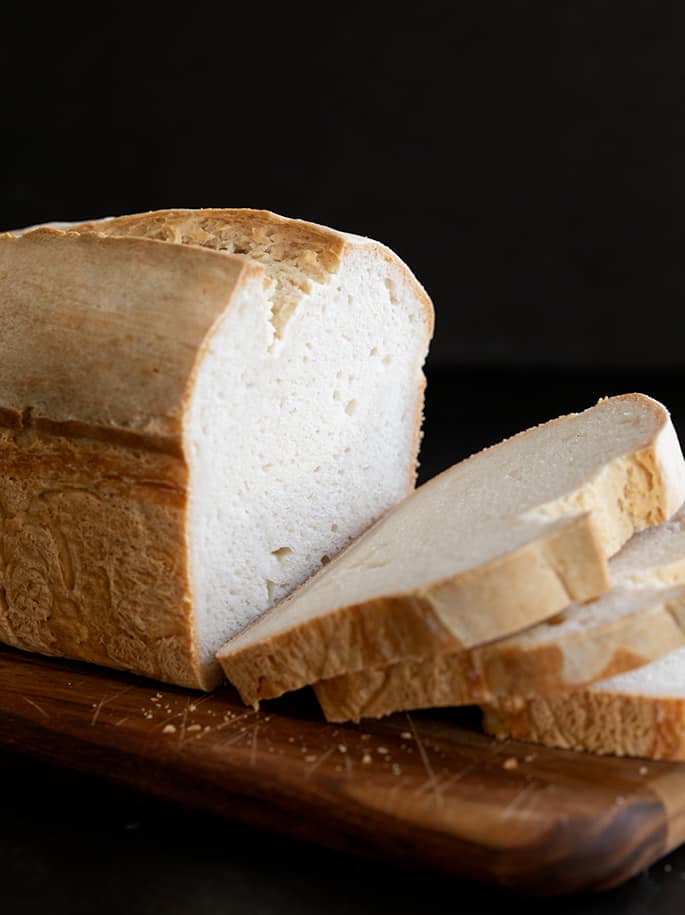

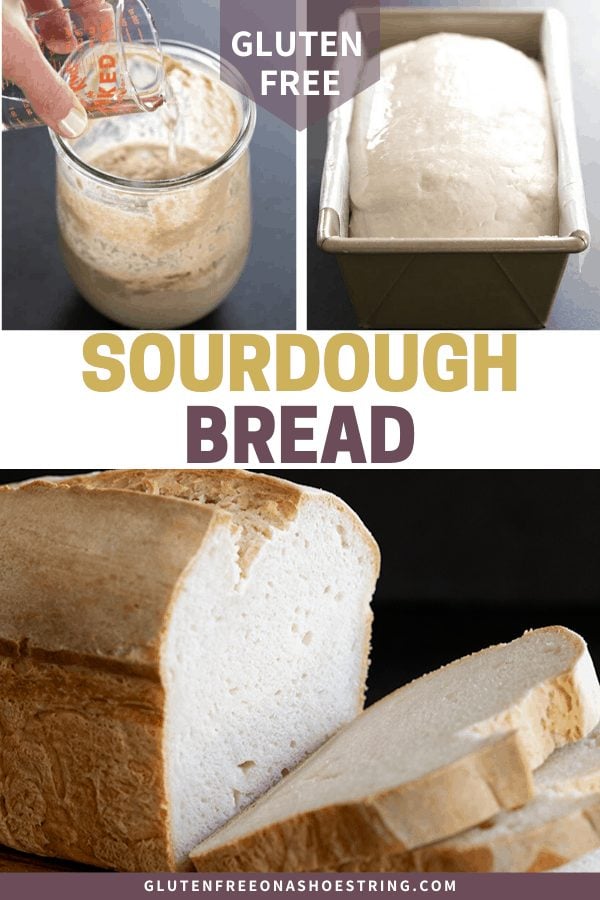
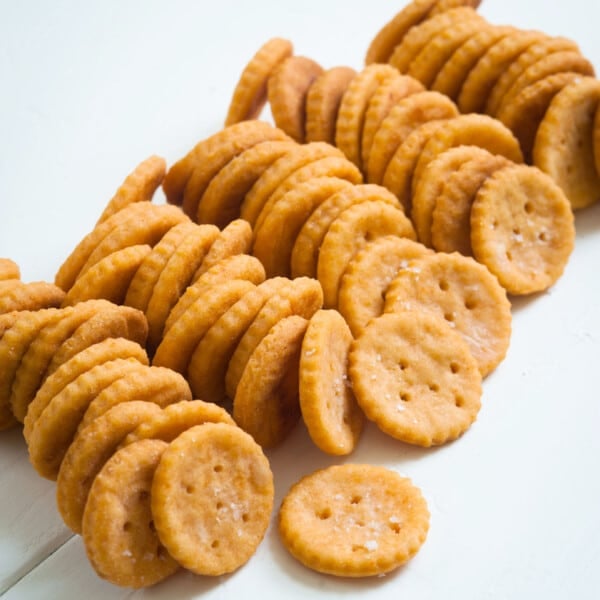


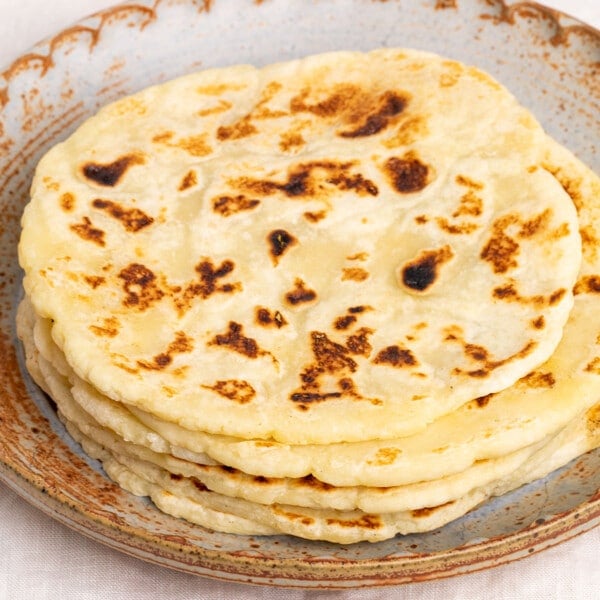









So disappointed. My starter was on it’s 8th day and fed last night. Made this morning . I used a mixture of sorghum, teff and brown rice for the starter. It. U. Led and had a beautiful sweet smell. I heated the oven to 200 F and turned off and let cool a bit thinking that would be a warm place to rise. Let it rise 6 hours. Cooked and thermometer said 200 degrees. When I cut into it, it is doughy. Gummy. Read other posts. Oven too hot? Didn’t rise enough? any suggestions?
It’s never a good idea to set dough to rise in an oven that has been turned on, even to the lowest temperature. It is often too hot to rise, and not hot enough to bake, so it kills the yeast. If it did rise, but just didn’t cook all the way through, then it sounds like it simply didn’t bake for long enough. The internal temperature + the hollow thumping sound are necessary. Otherwise, your gauge likely went into a spot that was baked, but it wasn’t baked all the way through.
Temp and cooking time? I couldn’t find it anywhere in the recipe, I did, however, see on the video to cook at 400 degrees approx how long does it cook?
Please see Step 5, Lori. All of the information is there.
Oh sorry I was vague. I have been feeding my starter brown rice flour. I made the loaf with Mock Better Batter.
Nicole: Thanks for the recipie! I fed my starter for seven days with sweet sorghum and brown rice. I ran out of sorghum and had to switch to a mix of brown rice/buckwheat so hope I don’t end up with a wonky flavour. My dough looks quite heavy in the pan but will let you know how it turns out. I poured off the hooch daily but missed a step where it said to discard 1/3 of the mixture (is that the hooch or the actual flour mix?) Last question, I now have a fair bit of starter, is there another recipie I could try also with this mix? Thank you kindly- hope you and family are staying safe through this pandemic!
The discard is 1/3 of the starter, Patricia. It always has to be that you’re discarding (or at least removing) actual starter for you to maintain an active starter, and one that doesn’t grow exponentially. The yeast won’t thrive otherwise. I don’t have any other wild yeast sourdough starter recipes available for free on the blog.
Am super excited to try your gf starter in a couple of days. Just a quick question Nicole, I have my own glutenfree blend of flour I sell which is a combo of brown rice , sorghum, tapioca and raw banana flour . Have never tried a bread though , was wondering if I could make the above recipe with my blend ? What are your comments please on the same ?
Definitely not, Namrata. If you have such a unique blend like that you’ll need a recipe that is designed for that blend. In none of my recipes would that blend qualify as an “all purpose” blend.
OMG, my first ever sour dough starter and first ever sour dough bread – it was easy, it worked, and it’s delicious! Thank you, thank you! I may never buy grocery store GF sandwich bread again. FYI, I made this entirely with cup 4 cup and it worked fine.
So glad everything worked out for you, Alison. Your first successful wild yeast sourdough experience should earn you like a badge or something, don’t you think? You really feel like you made something out of nothing. ?
The Expandex finally came in the mail, (yay!) but in the process of converting my liquid starter to the stiff Mother Starter (per instructions in the book) I panicked when it was overly dry and wouldn’t come together into a ball. I put more water in without measuring and then, against my better judgment, a scoop more of the liquid starter when the Mother Starter was still too dry to form a ball in the stand mixer. The Mother Starter did finally come together and doubled in size over the next 7.5 hours, so I kneaded it and put it in the fridge. My main question is: is it ok to use? I’m assuming it might be a little more active than it’s supposed to be but that it won’t be toxic or dangerous to consume? I don’t know how delicate a balance there is between the yeast and flour and water, and if necessary, I have more liquid starter and can start all over again — but I’m hesitating because it’s such a lot of ingredients and waste.
As to how I reached this place, I kept the liquid starter going about 5 days longer than the book says while I waited for the Expandex to arrive. Since I had read somewhere that I could pour the hooch off the top of the liquid starter for a milder flavor, I began to do that, but the liquid starter began to take on a much stiffer form. It would double in size every 12 hours and smelled like bread, absolutely delicious but quite thick. I also put it in the fridge so I wouldn’t have to feed it every 12 hours. Pouring off the hooch may have contributed to the dryness of the Mother Starter when I tried to convert it. Also, I am using pea protein instead of whey protein, and initially I forgot to use 150% water when converting the liquid starter to the Mother Starter, which provides another explanation for the dryness of the Mother Starter.
Thanks for helping me trouble shoot! I so want to make the gluten free rye bread, but don’t want to inadvertently jeopardize the health of my family.
Hi, Suzanne,
I’m afraid I can’t promise that your Mother Starter will have the proper constitution to work in recipes, but I can reassure you that it won’t poison your family! Don’t worry, and trust your nose. We are built to avoid eating something poison. ?
Made this loaf yesterday. I had made my starter the week before, using sorghum and brown rice flour, and used the gum free blend to feed it for a week. Essentially followed exact directions for that recipe. I followed the directions to the letter when making the bread. It rose beautifully, for 4+ hours, hitting the top of my loaf pan. I put it in the oven, and cooked according to directions.
It actually deflated in the oven, had sides that (once out/cooled) collapsed down. It was super gummy on the bottom and not cooked on the bottom half. The top half was better, but still not fully cooked apparently. I used my instant read thermometer to test. It was just over 200* and the probe came out clean. I used Better Batter.
Any thoughts? What would cause the sides to collapse down? Over proofing? Oven not hot enough? Too hot? I want to try again, though, as the flavor was great. (I am not new to GF baking. Been using your recipes with great success for years!) Thanks!
Hi, Holly, It sounds like a too-hot oven. Most ovens do run hot, so it’s really best to use a cheap instant read oven thermometer as your guide, not the oven’s gauge.
It’s unlikely the loaf overproofed, although it’s always possible. Without being there with you, it’s nearly impossible for me to know, but you asked for my thought so I’m happy to provide them! When baked goods rise (usually quite quickly) and then fall, it’s typically because the outside cooked too quickly and is in danger of burning before the inside has a chance to create a proper structure to support it. Your instant read thermometer would still come out clean if you happened to place the probe in a spot that was fully baked. That’s part of why you also want to make sure the loaf sounds hollow when thumped with your finger on the bottom. That indicates that there shouldn’t be any uncooked portions. I hope that’s helpful!
Hi Nicole, I made the sourdough starter with buckwheat flour over 6 days and it looked perfect so I made the bread this morning having let it rise overnight. So disappointed with the result. The bread didn’t rise and is so dense. I live in the UK and I have never come across Better Batter so I used Doves gf bread flour. Do you think that’s the problem?
Yes, that is certainly part of the problem. I’ve only ever heard good things about using Dove’s Farm plain flour when my recipe calls for Better Batter, but I couldn’t even promise that that would work here. I’m sure their bread flour is something different entirely. I think they have a recipe for sourdough bread on their website. Maybe try using that instead, if you can’t build my mock Better Batter with the recipes I’ve provided.
I made this bread last night. I have been feeding a starter for about 2 weeks, and it was responding well after feedings. I mixed up the proper amount of your Mock Better Batter for this. I let it rise overnight, a total of about 14 hours. I thought it grew about 130%. It doesn’t seem like it grew very much in the oven at all. When the timer went off the temp of the bread was 200 deg F, but I noticed it was very gummy. So I put it in for another 6 minutes. Unfortunately, it has a gummy, sweaty bottom. Do you think it was my starter? If it doesn’t rise the 150% when I try again, should I toss it and start over?
It sounds like maybe you used another recipe for the wild yeast starter, Jaclyn? My starter never calls for Better Batter (mock or otherwise). I’m afraid without knowing more, I have to assume that your bread turned out gummy because of your starter, yes.